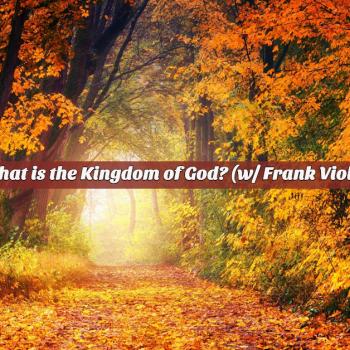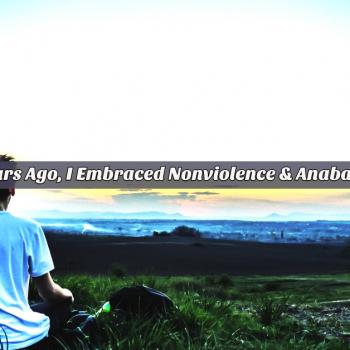THE CREED: Anabaptist Reflections on the Apostles’ Creed (part 2)
I believe in God, the Father almighty,
creator of heaven and earth.
I believe in Jesus Christ, his only Son, our Lord,
who was conceived by the Holy Spirit,
born of the Virgin Mary,
suffered under Pontius Pilate,
was crucified, died, and was buried;
he descended to the dead (or hell).
On the third day he rose again;
he ascended into heaven,
he is seated at the right hand of the Father,
and he will come to judge the living and the dead.
I believe in the Holy Spirit,
the holy catholic Church,
the communion of saints,
the forgiveness of sins,
the resurrection of the body,
and the life everlasting.
Amen
God is the Father of all creation. God is the life source. We confess this if we are going to be authentically Christian. Of course, there is plenty of room for discussion on the nuances of this statement.
Alister McGrath lists four implications of the doctrine of creation, all of which are compatible with the Anabaptist tradition. First, there is a need to see a distinction between God and the creation. Second, if God is truly the creator, the implication of such a declaration is that this same God is authoritative over all that exists. A Christian theology of this sort then recognizes the stewardship role of humankind of the earth. Humans do not own the world. Third, creation is good – in fact, it is “very good.” To say such does not imply that the world as it presently exists is perfect. Rather, it is has intrinsic value.[1] Christopher J.H. Wright states:
So the earth has intrinsic value—that is to say, it is valued by God, who is the source of all value. God values the earth because he made it and owns it. It is not enough merely to say that the earth is valuable to us. On the contrary, our own value as human beings begins from the fact that we ourselves are part of the whole creation that God already values and declares to be good…we take our value from the creation of which we are part, not vice versa.[2]
Wright not only rightly attributes worth to God’s world, but sees humanity as part of the whole. This leads to a brief mention of the fourth area of implication, humans as created in God’s image. St. Augustine’s words give us one dimension of this: “You made us for yourself, and our hearts are restless until they find their rest in you.” These words remind us that humanity shares a unique connection to the Creator.[3]
Purpose of Creation Texts?
Having mentioned the broad implications of what it means to believe that God is the Creator, we now ask: What is the purpose of the creation texts in the Bible? I contend that they have little to do with science and have more to do with the questions the Israelites were asking in the midst of exile. Genesis 1, along with the rest of the Torah, came into its final form in the post-exilic period. Reading Genesis in light of exile brings more depth to the doctrine of creation, and is compatible with the Anabaptist suspicion towards oppressive Empires.
First, an exilic approach recognizes that Genesis 1 is a poetic-narrative (liturgy) that was intentioned to confront the Babylonian Empire’s oppressive hierarchical structure of organizing the world.
Secondly, this reading allows for the direct confrontation against oppressive theologies that claim that this world is the product of violent power struggles (such as Enuma Elish) rather than God’s love taming chaotic forces. Peter Enns states:
Placing Genesis in its ancient Near Eastern setting strongly suggests that it was written as a self-defining document, as a means of declaring the distinctiveness of Israel’s own beliefs from those of the surrounding nations. In other words, Genesis is an argument, a polemic, declaring how Israel’s God is different from all the other gods, and therefore how Israel is different from all the other nations.[4]
Clearly Genesis proclaims that God is the creator of the universe, but this text has a deeper rhetorical purpose than giving scientific data. This passage proclaims the superiority of Israel’s God, the God who dignifies what is created.
What Does it Mean to Claim God as Creator?
In the ancient world, to say that something is “created” had a different meaning than it does for modern people. In modernity, to create is to typically take things that do not exist and to then design something out of nothing. In classical theology this has been labeled “creation ex nihilo.” In an effort to curb Gnostic dualistic thinking, the idea of an “out of nothing” creation became in a sense canonized by about the 4th century.[5] Although this was preventative step to avoid heresy at the time, the unfortunate result is that the “ex nihilo”[6] reading of Genesis 1 disregards the ancient context in which the chapter was originally composed.
In the ancient world, to “create” had to do with taking things that already existed and arranging them to function with a purpose. In this way, God took the chaos and tamed it into a functional system. This is all for the benefit of humankind, who bear God’s image.
Probing deeper, we find that the word “create” in Hebrew is “bara.” Every time this word is used in the Old Testament it is used in a functional sense, not a material sense. This further emphasizes that the way God sustains the cosmos through working to “order” all things. God maintains the kind of world where humanity can flourish.[7]
Complementarily, the proclamation of God as creator carries with in the idea that God makes the whole universe a cosmic temple. The 7-day pattern of creation mirrors the inauguration ceremony of the tabernacle and temple in the Old Testament (not to mention non-biblical temple celebrations). On the seventh day, God “rests” which essentially means that God is at work to make sure that creation continues to function for the purposes of human image-bearers.[8] For this reason the Psalmist can exclaim: “Lord, you have done so many things! You made them all so wisely! The earth is full of your creations!” (104.24).
God Creates God’s Image
My conviction is that to be the “image of God” is to be a reflector of God’s love into the creation project. Just as kings in the ancient world would place statues (images) of themselves in colonies so that subjects knew what their king was like, so God has placed humankind in the world to show the rest of creation what God is like. A distinction here takes us back to the polemical nature of Genesis 1. The kings of Empire set up a kingly system of dominance, yet the language in Genesis about the image of God sets up all humanity as equals!
J. Richard Middleton writes, “But whereas power in the Babylonian and Assyrian empires was concentrated in the hands of a few, power in Genesis 1 is diffused or shared.”[9] In this way, all are empowered to live in light of God’s functional cosmos, as stewards of God’s care and love for creation.
Created for Shalom
The early chapters of Genesis confront the patterns of Babylon. A single word summarizes this in-your-face challenge: shalom. Ironically, the Hebrew word for peace might actually be the most confrontational word in the whole Bible.
In God’s eyes, when the world is functioning as designed, it is “very good.” This becomes possible when people embrace the vocation of imaging God to the world. Scot McKnight points out that humanity was created as Eikons (image-bearers) to live in four harmonious relationships: to God, others, self, and creation.[10] Anabaptist and Jewish writers refer to this harmonious, God-ordained web of relationships as “shalom.”[11]
Anything that alienates these relationships from each other disrupts what God ordered; this is sin. The solution to this relational disharmony came when Jesus showed us how to perfectly live out shalom, as the true image of God. The more we become like him, the more we become fully human.
* For an in depth look at the Genesis 1-3 texts, check out my series “Evolving Evangelicalism”
[1]. Alister E. McGrath, Christian Theology: An Introduction, 3rd ed. (Malden, MA: Blackwell Publishers, 2001), 299.
[2]. Christopher J.H. Wright, The Mission of God: Unlocking the Bible’s grand Narrative (Downers Grove, Ill.: IVP Academic, 2006), 399.
[3]. McGrath, Christian Theology: An Introduction, 300.
[4]. Peter Enns, The Evolution of Adam: What the Bible Does and Doesn’t Say about Human Origins (Grand Rapids, MI: Brazos Press, 2012), 6.
[5]. McGrath, Christian Theology: An Introduction, 298.
[6]. This is not to say that “materiality” was not also at some point created by God. By the New Testament period, this is proclaimed as well. It simply reminds us that ancient Jews did not think about creation the way that we do.
[7]. John H. Walton, The Lost World of Genesis One: Ancient Cosmology and the Origins Debate (Downers Grove, Ill.: IVP Academic, 2009), 26.
[8]. Walton, The Lost World of Genesis One, 75.
[9]. J. Richard Middleton, The Liberating Image: The Imago Dei in Genesis 1 (Grand Rapids, MI: Brazos Press, 2005), 204.
[10] Scot McKnight, The Blue Parakeet: Rethinking How You Read the Bible (Grand Rapids, Mich.: Zondervan, 2008), 68-71 and Scot McKnight, Embracing Grace: A Gospel for All of Us (Brewster MA: Paraclete Press, 2005), 18-19.
[11] See: Bernhard Ott, God’s Shalom Project (Intercourse, PA: Good Books, 2004).












